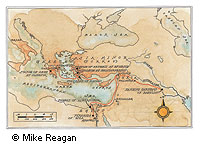 |
| |
 | |
 | |
 | |
 |
| ||||||||||||||||||||||||||||||||||||
|
Journey to the Seven Wonders Though only one of the ancient marvels still stands, they still engage our imagination—and launch a thousand tours—more than two millennia later Visitors to the lobby of the Empire State Building in Midtown Manhattan are often surprised to find a series of pictorial stained-glass panels. Added in the 1960s, they were meant to link the great skyscraper to other engineering triumphs. These triumphs, however, are not the great symbols of modernity you might expect—other massive steel-and-concrete structures like the Hoover Dam or the Panama Canal—but the Seven Wonders of the Ancient World. Why should a collection of monuments more than 2,000 years old still inspire us—especially when six of the seven are no longer standing? "It's that word 'wonder,' " says David Gilman Romano, professor of classics at the University of Pennsylvania. "If you just called them the Seven Architectural Marvels, it wouldn't have he same impact." Then, too, the one that does survive—the Pyramids of Giza—is sufficiently stunning to convince us that the ancients weren't exaggerating the splendor of the other six. It's also our passion for ordering the world. "We are living in a time very much like that of the Hellenic period," says Larissa Bonfante, professor of classics at New York University. "The Greeks loved to have things categorized—they loved anything out of the ordinary—and so do we." In our chaotic age, bombarded as we are with new technologies and rapid cultural change, we still seem to yearn for the security of mutually acknowledged "greats"—whether it be Impressionist painters, Citizen Kane, the Washington Monument, Cartier-Bresson photographs or the Hanging Gardens of Babylon. | ||||||||||||||||||||||||||||||||||||
| ||||||||||||||||||||||||||||||||||||
|
For more information on this topic, see our Additional
Sources page or explore the Archives of Smithsonian
Magazine:
| ||||||||||||||||||||||||||||||||||||
|
To purchase a copy of the June 2004 issue, click here. | ||||||||||||||||||||||||||||||||||||
|
Abstract of an article by Tony Perrottet originally published in the June 2004 issue of Smithsonian. All rights reserved. | ||||||||||||||||||||||||||||||||||||
|
Copyright 2004. Smithsonian Institution. All rights reserved. Email subscription questions to: smithsmt@palmcoastd.com Email other inquiries to: email@simag.si.edu | ||||||||||||||||||||||||||||||||||||
 |


